If you want to spot where your infinity pool might be leaking, start by inspecting for cracks in the shell, surface deterioration, or damage around the edges and spillways. Check plumbing connections and seals for wear or leaks, and look for signs of damage in tiles and waterproofing layers. Mechanical parts like pumps and filters can also cause issues. Understanding these common failure points can help you catch problems early—there’s more to uncover as you continue exploring.
Key Takeaways
- Structural cracks from ground shifts or temperature changes can lead to leaks if left unrepaired.
- Failures in overflows, weirs, and pool edges cause silent water loss and uneven water levels.
- Plumbing system issues, including loose fittings and damaged waterproofing layers, are common leak points.
- Deteriorated grout, loose tiles, and spillway erosion allow water escape and structural damage.
- Mechanical seal wear, misaligned connections, and hidden cracks require regular inspection and maintenance.
Common Cracks and Fractures in Pool Shells
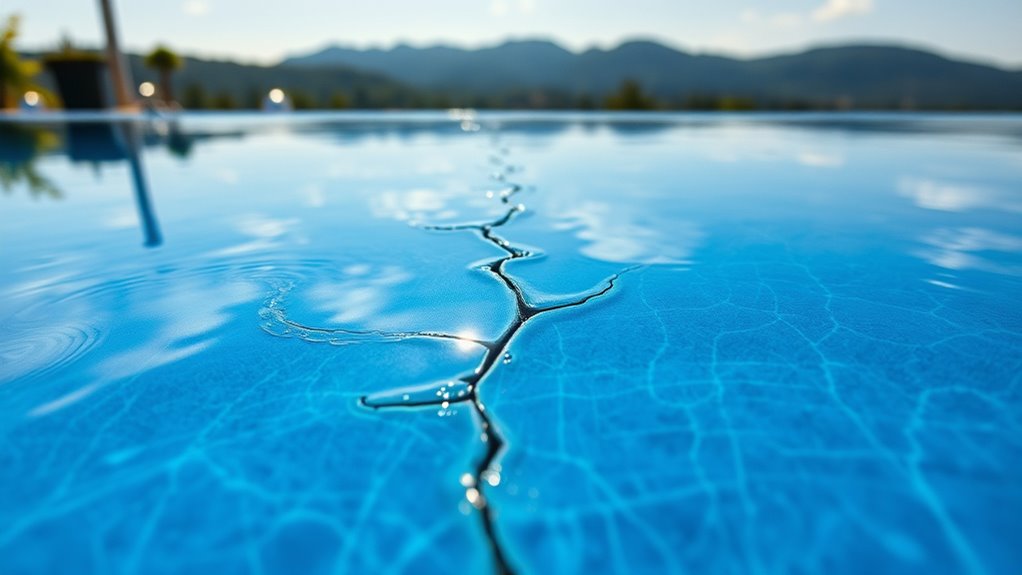
Cracks and fractures in pool shells are common issues that can lead to leaks if not addressed promptly. You might notice small cracks forming from ground shifts, temperature changes, or structural stress. These fractures often develop over time, especially in older pools or those exposed to extreme weather. If left untreated, even tiny cracks can expand, allowing water to seep through and cause significant damage. You should regularly check the pool’s surface for visible signs of damage, such as hairline cracks or fissures. Addressing these issues early prevents larger leaks and costly repairs later. Using appropriate repair materials like epoxy or pool patch kits can seal minor cracks effectively. Ignoring cracks compromises the pool’s integrity and can lead to more severe leaks down the line. Additionally, understanding the AI capabilities in mobile devices can aid in monitoring and diagnosing pool issues through smart technology integration.
Failures in the Overflows and Weirs

Failures in the overflows and weirs can profoundly impact your pool’s water balance and overall functionality. When these components crack, break, or become misaligned, they can cause water to leak silently, making it hard to notice until water levels drop or maintenance issues arise. Overflows and weirs are designed to control water flow and prevent splashing, but damage to them can lead to uneven water levels and increased evaporation. You might notice water seeping around the edges or hear unusual sounds during operation. If ignored, these failures can strain the pool’s filtration system and cause water quality problems. Regular inspections are essential to identify cracks or damage early, ensuring your overflow and weir systems function correctly and keep your pool balanced. Understanding industry trends can help you stay ahead of potential issues and maintain your pool’s optimal performance.
Leak Points in the Pool’s Plumbing System

Leak points in your pool’s plumbing system are common trouble spots that can lead to significant water loss if not addressed promptly. These leaks often occur at joints, fittings, valves, or aged pipes that have developed cracks or corrosion over time. You might notice a drop in water level without any obvious cause, or hear hissing sounds indicating escaping air or water. To pinpoint these leaks, inspect visible pipes, fittings, and connections for cracks, corrosion, or loose fittings. Pressure tests can help identify leaks in underground or inaccessible sections. Remember, even small leaks in your plumbing can cause substantial water loss and increase your energy costs due to pump overworking. Regular inspections and timely repairs are essential to prevent more extensive damage. Additionally, understanding how to detect early signs of leaks can save money and extend the lifespan of your pool system.
Faulty or Damaged Tile and Coping Joints
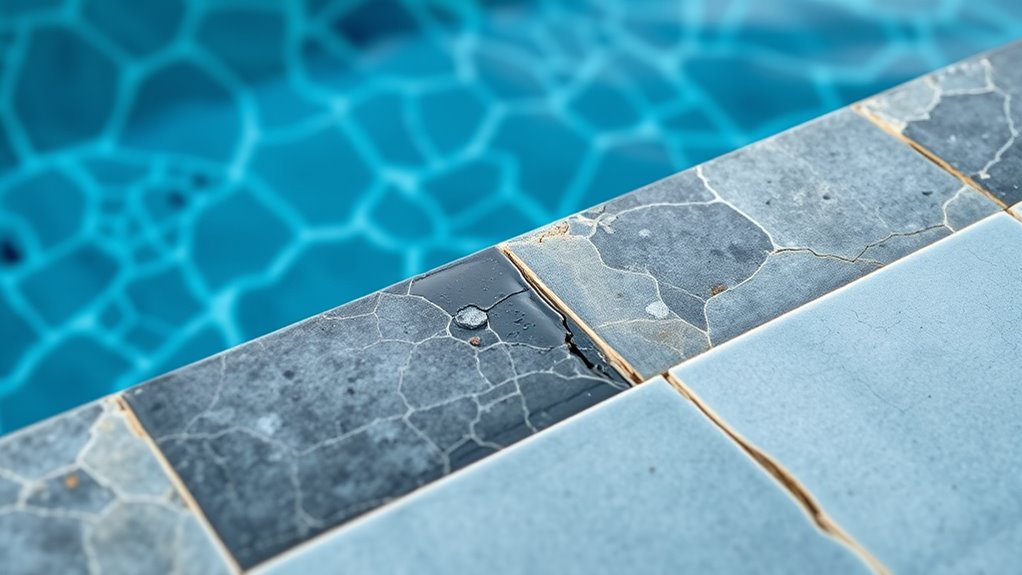
While plumbing leaks can cause significant water loss, issues with your pool’s tile and coping joints are equally problematic. Over time, these joints can crack, deteriorate, or loosen, allowing water to seep through. When grout or sealant fails, it creates pathways for water to escape or reach unintended areas, potentially causing structural damage. You might notice cracked or missing grout, loose tiles, or water pooling around the pool’s edge. These signs indicate compromised joints that need immediate attention. Ignoring damaged joints can lead to more serious issues like shifting tiles or water leaks into the pool’s structure. Regular inspection and maintenance help catch these problems early, preventing costly repairs and ensuring your pool remains water-tight and safe. Additionally, using high-quality filtration systems can help prevent debris and contaminants from exacerbating joint deterioration.
Issues With the Pool’s Waterproofing Layer
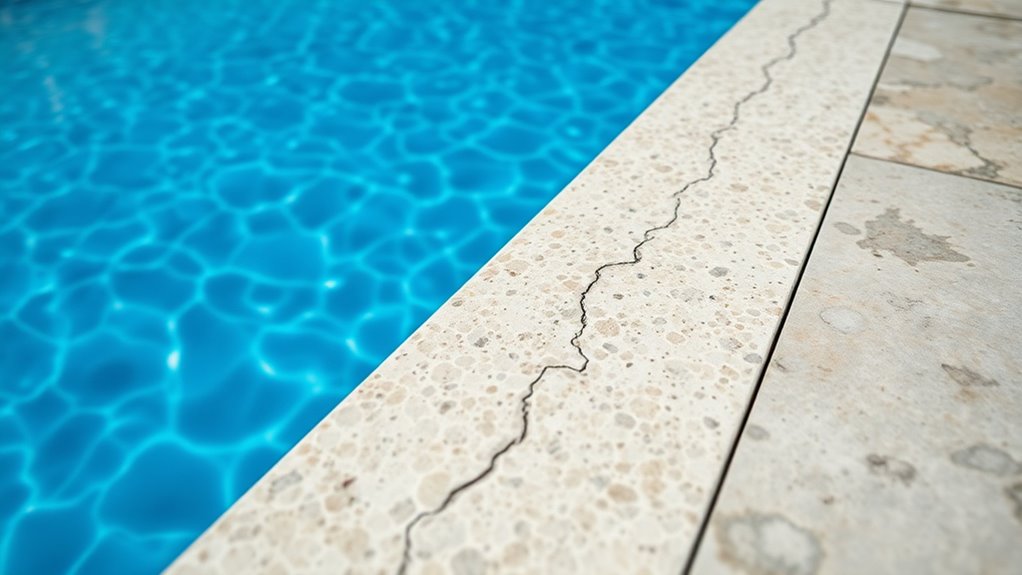
Issues with your pool’s waterproofing layer can lead to significant water loss and structural damage if not addressed promptly. Cracks, tears, or deterioration in this layer allow water to seep into surrounding materials, weakening the pool’s foundation. Over time, this can cause uneven settling or cracks in the pool shell. Poor application during construction or exposure to harsh chemicals and UV rays accelerate the deterioration process. You might notice unexplained drops in water levels or damp spots around the pool. If you ignore these signs, the problem worsens, increasing repair costs and risking more extensive damage. Regular inspections of your waterproofing layer help catch issues early. Addressing minor damages quickly prevents leaks from escalating into major structural problems, ensuring your pool remains safe and functional. Utilizing appropriate detection tools can significantly improve early leak identification and repair efficiency.
Problems at the Pool’s Skimmer and Return Fittings
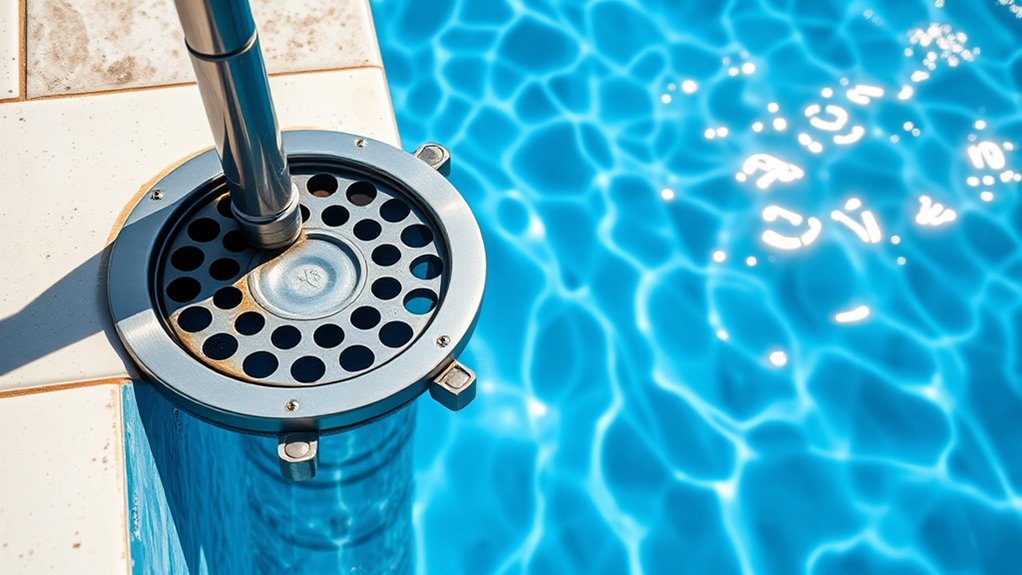
Problems at the pool’s skimmer and return fittings can cause significant water loss and circulation issues. Cracks, loose fittings, or damaged seals can allow water to escape, often unnoticed until you see low water levels or increased chemical use. A loose skimmer can leak water directly into the surrounding area, while a faulty return fitting might spray water unevenly or leak around its edges. These issues disrupt proper water flow, leading to poor filtration and increased wear on the pump. Additionally, air can enter the system through leaks, causing bubbles or noisy operation. Regular inspection of fittings, tightening loose components, and replacing damaged seals can prevent leaks and guarantee your pool circulates efficiently. Addressing these problems promptly keeps water levels stable and maintains overall pool health. Proper maintenance and leak detection techniques can help identify issues early before they cause significant damage.
Leaks in the Pool’s Pump and Filter Connections
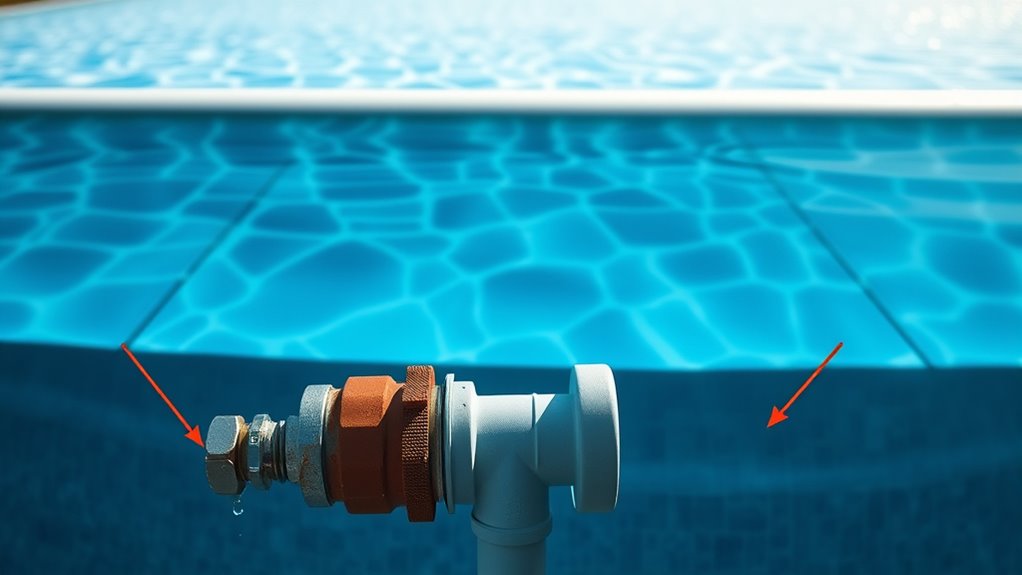
Leaks around your pump and filter connections are common and often easy to fix. You should check for loose fittings or worn seals that might be causing water loss. Regular tightening and maintenance can prevent many of these issues from becoming bigger problems. Additionally, inspecting your pool’s self-watering system components can help identify if any moisture-related issues are contributing to leaks.
Pump Connection Leaks
When your pool’s pump and filter connections start to show signs of dripping or moisture, it’s often a clear indication that a leak has developed. These leaks usually occur at the fittings, where hoses connect to the pump or filter. Over time, these connections can loosen or the seals can degrade, allowing water to escape. You might notice puddles near the equipment or a drop in water level without obvious cause. To address this, turn off the pump and inspect the fittings closely. Tighten any loose connections and replace worn or damaged O-rings or seals. Ensuring a secure, watertight connection is essential to prevent ongoing leaks and protect your pool’s equipment from damage. Regular checks can catch leaks early before they escalate. Additionally, understanding the importance of contrast ratio can help in diagnosing if leaks are causing uneven water levels or pressure issues within your system.
Filter Seal Issues
Ever notice water seeping from your pool’s pump or filter connections despite everything appearing tight? This often indicates a filter seal issue. Over time, the rubber or gasket seals can wear out, crack, or become misaligned, allowing water to escape. Even a small gap can cause significant leaks and reduce your system’s efficiency. Check the seals around the pump and filter connections carefully. If you see cracks or deterioration, replacing the seals is your best option. Sometimes, the seals may be properly in place but still faulty. Avoid overtightening fittings, as this can damage the seals further. Regular inspection and timely replacement of worn seals help prevent leaks and keep your pool running smoothly. Additionally, understanding your water quality and flow rate needs can help you select the appropriate replacement seals and media for optimal system performance.
Tightening and Maintenance
Properly tightening and maintaining your pool’s pump and filter connections is essential to prevent leaks and guarantee efficient operation. Loose fittings can cause significant water loss and damage your equipment. Regularly inspect connections for signs of wear or corrosion. Use the correct tools and torque specifications to ensure a snug fit without over-tightening. Additionally, adhering to safety standards during maintenance helps prevent accidents and extends the lifespan of your equipment. Consider these critical steps: 1. Check for leaks daily—early detection saves money and hassle. 2. Tighten fittings correctly—avoid damaging threads or seals. 3. Replace worn seals immediately—prevent small issues from turning into big leaks. 4. Schedule routine maintenance—keeping connections secure prolongs equipment lifespan. Taking these proactive steps keeps your pool running smoothly and prevents costly repairs.
Wear and Tear in the Pool’s Edge and Spillway Areas

Over time, the pool’s edge and spillway areas are prone to wear and tear due to constant exposure to water, chemicals, and foot traffic. The continuous contact with chlorinated water can erode grout and loosens tiles, creating gaps that weaken the structure. Foot traffic adds stress, causing cracks or chips in the coping stones or concrete. Over time, these small damages can expand, leading to leaks or water loss. The spillway’s surface may also degrade, resulting in erosion or uneven surfaces that allow water to escape. Regular inspections help you spot early signs of deterioration. Addressing these issues promptly guarantees the integrity of your pool’s perimeter, preventing leaks and costly repairs down the line. Proper maintenance keeps your pool safe and functional.
Detecting Small Leaks in the Pool Structure
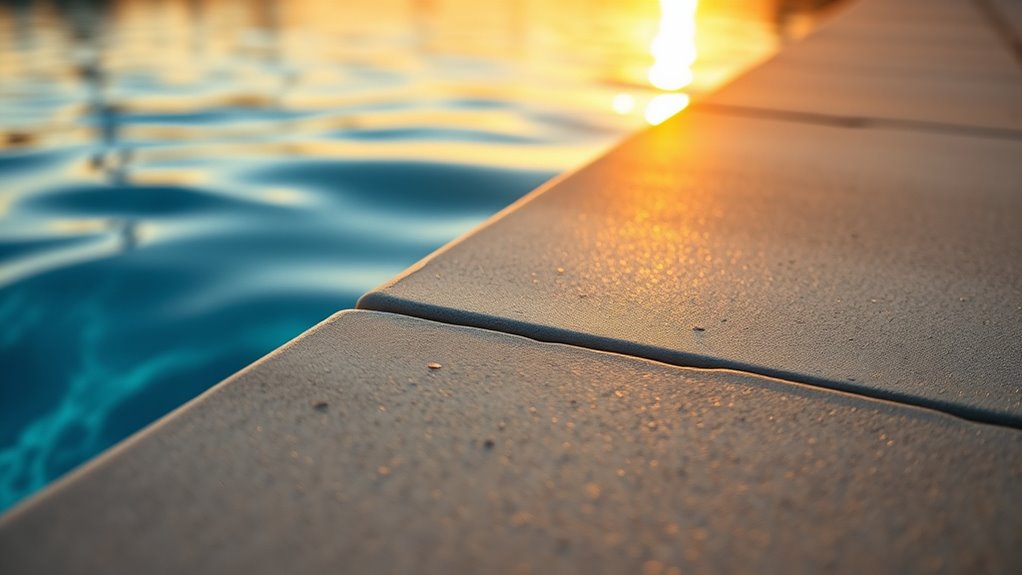
How can you spot small leaks before they turn into major problems? The key is paying close attention to subtle signs. First, monitor water levels daily—any unexplained drop signals a potential leak. Second, listen for unusual sounds like hissing or dripping near the pool structure. Third, inspect the pool’s surface for tiny cracks or damp spots that seem new. Fourth, use dye tests around suspected areas; if dye moves unexpectedly, a leak is likely. Detecting small leaks early can save you from costly repairs and extensive downtime. Take action as soon as you notice any of these signs. The sooner you identify a small leak, the easier it is to fix, keeping your pool safe, sound, and enjoyable.
Signs of Hidden Leaks in Infinity Pool Features

Hidden leaks in infinity pool features can be difficult to detect because they often don’t produce obvious signs. However, certain clues can alert you to a problem. Look for uneven water levels, despite regular topping off. Cracks or water stains around the feature may indicate seepage. Unusual sounds, like dripping or gurgling, can also signal leaks. Additionally, check for increased evaporation rates or damp spots on nearby surfaces.
| Symptom | Possible Cause | Action |
|---|---|---|
| Uneven water levels | Hidden pipe or fitting leak | Inspect and repair leaks |
| Cracks/water stains | Structural seepage | Professional assessment |
| Unusual noises | Water flow issues or leaks | Leak detection services |
Frequently Asked Questions
How Can I Differentiate Between a Leak and Evaporation Loss?
To tell apart a leak from evaporation loss, monitor your water levels daily at the same time. If the water drops consistently over several days without rain or usage, it’s likely a leak. Evaporation, on the other hand, causes a slower, more predictable loss, especially during hot, dry weather. You can also perform a bucket test: fill a bucket with pool water, mark the water level, and compare it to the pool over 24 hours.
What Tools Are Best for Detecting Small Leaks?
Think of a stethoscope whispering secrets to you; it’s your best tool for detecting small leaks. Use electronic leak detectors to pinpoint subtle drops in pressure, and dye tests to reveal tiny cracks or holes. Sensor-based systems also serve as vigilant guardians, alerting you to even the faintest loss. Combining these tools allows you to uncover hidden leaks early, saving you time and costly repairs.
How Often Should Leak Inspections Be Performed on an Infinity Pool?
You should perform leak inspections on your infinity pool at least twice a year, ideally before and after the swimming season. Regular checks help catch small leaks early before they become major issues. Keep an eye on water levels, pool equipment, and surrounding areas for any signs of water loss or damage. Consistent inspections guarantee your pool remains in top condition, saving you money and preventing costly repairs down the line.
Can Algae or Debris Conceal Signs of Leaks?
Yes, algae and debris can hide signs of leaks in your infinity pool. They can obscure cracks, wet spots, or water loss indicators, making leaks harder to detect visually. Regular cleaning and inspection are essential; don’t rely solely on appearance. Using specialized leak detection methods, like dye tests or pressure checks, helps identify hidden leaks that algae or debris might conceal. Stay vigilant to keep your pool in top shape.
What Preventative Measures Can Reduce Leak Risks in Infinity Pools?
Did you know that regular maintenance can reduce leak risks by up to 30%? To prevent leaks in your infinity pool, routinely inspect the seals and plumbing connections, especially around the spillway and tile line. Keep the water levels consistent and clean filters often. Investing in a professional leak detection service annually can catch issues early, saving you costly repairs and water loss in the long run.
Conclusion
Don’t let hidden leaks ruin your infinity pool experience. Even small cracks or faulty joints can cause big problems over time, but with regular inspections and quick repairs, you can catch issues early. Some might think leaks are hard to detect, but staying vigilant and knowing where to look makes all the difference. Keep your pool in top shape and enjoy those stunning infinity views without worry—leak detection is your best defense.










